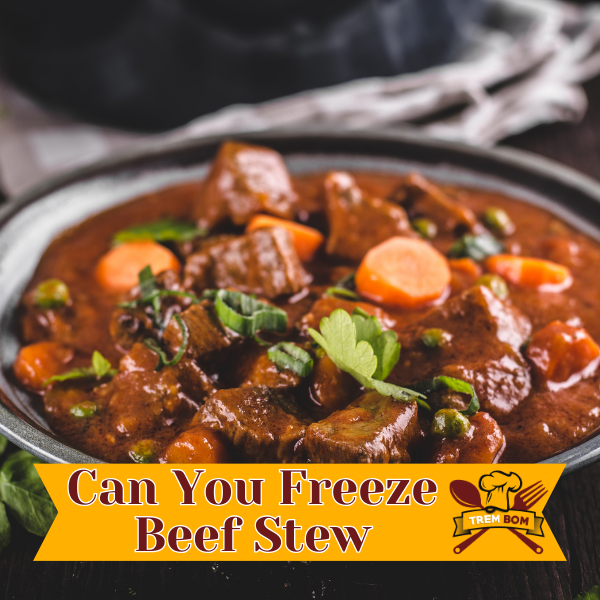
Are you wondering if it’s possible to freeze beef stew for later? The answer is yes! Freezing beef stew is a convenient way to store and enjoy this delicious dish whenever you want. Whether you’ve made a big batch or have leftovers from a family dinner, freezing beef stew is a practical solution to extend its shelf life without compromising its taste and texture.
In this article, we will explore the best practices for freezing beef stew, including packaging methods, portioning tips, and labeling techniques. We will also discuss the differences between freezing cooked beef stew and freezing raw ingredients, as well as the proper thawing and reheating methods. Additionally, we will touch on the shelf life of frozen beef stew and provide alternative ways to preserve this comforting meal.
Key Takeaways:
- Freezing beef stew is a great way to extend its shelf life and enjoy it later.
- Proper packaging is essential for preserving the flavor and texture of frozen beef stew.
- Portioning the stew before freezing makes it easier to reheat and enjoy individual servings.
- Labeling your frozen beef stew helps with organization and easy identification.
- Alternative methods like canning or vacuum sealing can be used if freezing is not an option.
Understanding the Freezing Process
Before we dive into freezing beef stew, it’s important to understand how the freezing process works. Freezing is a method of preserving food by lowering its temperature, causing water molecules in the food to form ice crystals. These ice crystals help slow down the growth of bacteria and other microorganisms, which can cause food to spoil.
When it comes to freezing beef stew, the freezing process can have an impact on its taste and texture. As the stew freezes, the water molecules inside it expand, potentially leading to changes in its texture. Additionally, freezing can affect the flavor of the stew, with some ingredients becoming less flavorful after freezing.
Despite these potential changes, beef stew can still be successfully frozen and enjoyed at a later time. By understanding the freezing process and following proper freezing techniques, you can maximize the quality of your frozen beef stew.
Best Practices for Freezing Beef Stew
When it comes to freezing beef stew, following the best practices is crucial to maintain its quality and delicious flavors. Proper packaging, portion sizes, and labeling are key factors in ensuring your frozen beef stew remains tasty and convenient to use. Let’s explore these practices in detail:
Packaging Methods
Choosing the right packaging method for your beef stew is essential to prevent freezer burn and maintain its texture. Here are some recommended packaging options:
- Use airtight containers or freezer-safe bags to protect the stew from moisture and air exposure.
- Ensure all excess air is removed from the packaging to prevent freezer burn.
- If using bags, lay them flat and remove as much air as possible before sealing to maximize freezer space and prevent the stew from being crushed.
Portion Sizes
Properly portioning your beef stew before freezing makes it more convenient to thaw and use. Consider the following tips:
- Divide the stew into individual or family-sized portions based on your needs.
- Use freezer-safe containers or bags that are appropriate for the portion size to maintain optimal quality.
Labeling
Labeling your frozen beef stew is essential for easy identification and efficient freezer management. Here’s how you can effectively label your stored stew:
- Clearly label each package with the date of freezing to track its freshness.
- Include a description of the contents, such as “Beef Stew” and any additional ingredients or seasonings used.
By following these best practices, you can confidently freeze your beef stew, knowing that it will retain its quality and flavor when stored in the freezer.
Properly Packaging Beef Stew for Freezing
Preserving the flavor and texture of your beef stew when frozen depends greatly on proper packaging. By utilizing the correct techniques, you can ensure that your frozen beef stew remains delicious and enjoyable. Here are some tips and tricks to help you package your beef stew correctly for freezer storage:
- Choose the right containers: Opt for containers that are specifically designed for freezer storage. These containers should be airtight and leak-proof to prevent freezer burn and flavor transfer.
- Portion the stew: Divide the beef stew into individual or family-sized portions, depending on your needs. This makes it easier to thaw and reheat only the amount you require for each meal.
- Leave headspace: Leave some space at the top of each container to allow for expansion as the stew freezes. This prevents the containers from cracking or bursting in the freezer.
- Label the containers: Clearly label each container with the date of freezing and a description of the contents. This helps you keep track of freshness and easily identify your beef stew in the freezer.
- Remove excess air: If using freezer bags, squeeze out as much air as possible before sealing. This helps minimize freezer burn and maintain the quality of your beef stew.
- Stack containers efficiently: Arrange the frozen beef stew containers in an organized manner, allowing for easy access and space optimization in the freezer. Consider using stackable containers or freezer-safe storage bins for added convenience.
- Follow a “first in, first out” system: When placing the beef stew in the freezer, position the newest containers behind the older ones. This ensures that you use the oldest stew first and reduces the chances of forgetting about it.
By following these packaging guidelines, you can preserve the quality and taste of your beef stew for an extended period in the freezer. Not only will you have nourishing meals ready at your fingertips, but you’ll also experience the full deliciousness of your stew when it’s time to enjoy it.
Portioning Beef Stew for Freezing
Properly portioning your beef stew before freezing is essential for convenient and easy meal preparation. By following these recommended steps, you can ensure that your frozen beef stew is conveniently divided into individual servings, allowing you to defrost and enjoy them whenever you need a quick and delicious meal.
Step 1: Choose the Right Containers
When portioning beef stew for freezing, it’s important to use air-tight, freezer-safe containers that can withstand low temperatures without cracking or leaking. Opt for containers made of BPA-free plastic, glass, or heavy-duty freezer bags.
Step 2: Determine Portion Sizes
Consider the number of servings you typically need when determining the portion sizes for your beef stew. This will depend on your personal preferences and the number of people you are serving. A general guideline is to aim for individual serving sizes of around 1 to 2 cups per person.
Step 3: Cool the Stew
Allow your beef stew to cool completely before portioning and freezing. This helps prevent condensation and ice crystals from forming, which can affect the texture and taste of the stew.
Step 4: Portion and Pack
Divide the cooled beef stew into your chosen portion sizes using a ladle or measuring cup. Carefully transfer each portion into separate containers or freezer bags, leaving some headspace to allow for expansion during freezing. Make sure to seal the containers tightly to prevent freezer burn.
Step 5: Label and Date
To keep your frozen beef stew organized, label each container or bag with the contents and the date it was frozen. This will help you keep track of the storage time and ensure you consume the stew within its recommended shelf life.
Tip: Vacuum-sealing your beef stew portions can help extend its freezer life and maintain the quality for longer periods.
Step 6: Freeze and Store
Place the portioned and labeled beef stew containers in the freezer, making sure they are stored in a flat position to maximize space. Keep the stew away from any potential sources of odor or cross-contamination, such as strong-smelling foods.
Step 7: Enjoy at Your Convenience
When you’re ready to enjoy your frozen beef stew, simply transfer the desired portion from the freezer to the refrigerator and allow it to thaw overnight. Once thawed, reheat the stew on the stovetop or in the microwave until heated through. Serve with your favorite side dishes for a comforting and convenient meal.
Recommended Portion Sizes for Freezing Beef Stew
| Number of Servings | Portion Size (Cups) |
|---|---|
| 1 | 1-2 |
| 2 | 2-4 |
| 3-4 | 4-6 |
| 5-6 | 6-8 |
Labeling Frozen Beef Stew
When it comes to freezing beef stew, proper labeling is key to easy identification and effective freezer management. By following these useful tips for labeling your frozen beef stew, you can stay organized and ensure that your meals are readily accessible when you need them.
1. Date and Description
Start by clearly labeling each container with the date of freezing. This will help you keep track of the stew’s freshness and storage duration. Additionally, write a brief description of the contents, including any special ingredients or variations, to avoid any confusion later on.
2. Portion Sizes
If you have divided your beef stew into individual portions before freezing, it’s essential to label each container with the serving size. This will help you defrost only what you need, avoiding wastage and ensuring portioned meals.
3. Reheating Instructions
Consider including reheating instructions on the label to make meal prep even easier. Whether it’s stovetop, microwave, or oven reheating, clear instructions will save you time and make the process stress-free.
4. Storage Life
For optimal food safety, it’s important to label your frozen beef stew with the recommended storage life. This can vary depending on the ingredients used and the freezing method employed. Check the recipe or consult food safety guidelines for guidance on the appropriate storage duration.
By following these simple yet effective labeling tips, you can make the most of your frozen beef stew, ensuring easy identification, proper portioning, and convenient meal preparation.
Freezing Cooked Beef Stew vs. Raw Ingredients
When it comes to freezing beef stew, you have two options: freezing it after it has been cooked or freezing the raw ingredients to be cooked later. Both methods have their pros and cons, so let’s dive into the details to help you make an informed decision.
Freezing Cooked Beef Stew
If you have a batch of delicious, fully cooked beef stew that you’d like to freeze for future meals, it is certainly possible. Freezing cooked beef stew can be a convenient option, as it allows you to have ready-to-eat meals without the need for extensive preparation.
“Freezing cooked beef stew can be a convenient option, as it allows you to have ready-to-eat meals without the need for extensive preparation.”
One advantage of freezing cooked beef stew is that the flavors have had time to meld together during the cooking process. This can result in a more flavorful and deeply satisfying stew when thawed and reheated.
However, one drawback of freezing cooked beef stew is that the vegetables and other ingredients may become softer and slightly mushy when thawed and reheated. This is because the cooking process has already broken down some of their textures.
Freezing Raw Beef Stew Ingredients
If you prefer the idea of having more control over the cooking process or enjoy the fresh crunch of vegetables in your beef stew, freezing the raw ingredients may be the way to go. By freezing the raw beef, vegetables, and other ingredients separately, you can preserve their individual textures and flavors.
By freezing raw beef stew ingredients, you have the flexibility to adjust the cooking time and seasonings when you eventually prepare the stew. This can result in a more personalized and customizable dish.
“By freezing raw beef stew ingredients, you have the flexibility to adjust the cooking time and seasonings when you eventually prepare the stew.”
One point to keep in mind when freezing raw beef stew ingredients is that you will need to allocate additional cooking time and effort when it comes to preparing the stew. It will require assembling and cooking all the ingredients together, which may be more time-consuming compared to simply thawing and reheating a pre-cooked stew.
To summarize, here’s a handy table outlining the key differences between freezing cooked beef stew and freezing raw beef stew ingredients:
| Freezing Method | Pros | Cons |
|---|---|---|
| Freezing Cooked Beef Stew | – Convenient ready-to-eat meals. – Deep flavors from the cooking process. |
– Softer textures of vegetables when reheated. |
| Freezing Raw Beef Stew Ingredients | – Preserves individual textures and flavors. – Customizable seasoning and cooking process. |
– Additional cooking time and effort required. – Less convenience compared to pre-cooked stew. |
Ultimately, the decision between freezing cooked beef stew or raw ingredients depends on your personal preferences, convenience, and time availability. Both methods can yield delicious results, so choose the approach that best suits your needs.
Thawing and Reheating Frozen Beef Stew
Thawing and reheating frozen beef stew properly is crucial to maintain its taste and texture. Incorrect thawing or reheating methods can lead to loss of flavor and potential food safety concerns. Follow these simple steps to ensure your frozen beef stew remains delicious and safe to consume:
- Thawing in the Refrigerator: The best and safest method to thaw frozen beef stew is to transfer it from the freezer to the refrigerator. Place the frozen stew in a covered container or sealed bag and let it thaw slowly in the refrigerator overnight or for at least 24 hours. This gradual thawing process helps retain the quality of the stew.
- Thawing in Cold Water: If you’re short on time, you can also thaw the frozen beef stew by placing it in a sealed bag and submerging it in cold water. Change the water every 30 minutes to maintain a safe temperature. It’s important to never use hot water as it can promote bacterial growth.
- Reheating on the Stove: Once the beef stew is completely thawed, you can reheat it on the stove. Place the stew in a saucepan and heat it over medium-low heat, stirring occasionally to prevent sticking or burning. Ensure that the stew reaches a safe internal temperature of 165°F (74°C) before serving.
- Reheating in the Oven: Alternatively, you can reheat the beef stew in the oven. Preheat the oven to 325°F (163°C) and transfer the thawed stew to an oven-safe dish. Cover the dish with foil to prevent the stew from drying out, and heat it for approximately 30-40 minutes, or until it reaches the desired temperature.
Once the beef stew is reheated, it’s important to serve and consume it immediately to enjoy its flavors at their best. Avoid reheating the same portion multiple times, as it can affect the taste and texture of the stew.
Tips for Thawing and Reheating Frozen Beef Stew:
“Thawing and reheating frozen beef stew properly is essential to preserve its original flavors. By following these simple steps, you can ensure that every serving of your beef stew is as delicious as the day it was made.”
| Thawing Method | Recommended Time | Reheating Method | Recommended Temperature |
|---|---|---|---|
| Refrigerator Thawing | 24 hours or overnight | Stove | 165°F (74°C) |
| Cold Water Thawing | 2-3 hours (changing water every 30 minutes) | Oven | 325°F (163°C) |
Shelf Life of Frozen Beef Stew
Understanding the shelf life of frozen beef stew is essential for maintaining its quality. Proper storage and monitoring are crucial to ensure that your frozen stew remains safe and delicious to consume. Here, we will discuss the recommended storage durations for frozen beef stew and provide tips on how to determine if it is still good to eat.
Recommended Storage Durations for Frozen Beef Stew
When properly stored, frozen beef stew can retain its flavors and textures for an extended period. The freezer temperature plays a vital role in preserving the quality of your frozen stew. To ensure the best results, it is essential to maintain a consistent freezer temperature of 0°F (-18°C) or below. Here are some general guidelines for the recommended storage durations of frozen beef stew:
| Storage Duration | Quality and Flavor |
|---|---|
| Up to 3 months | Excellent quality and flavor |
| 3 to 6 months | Good quality and flavor |
| 6 to 12 months | Acceptable quality and flavor |
| Over 12 months | Flavor and quality may deteriorate |
Please note that these durations are general guidelines and can vary depending on the specific ingredients used in your beef stew recipe. For better results, it is always recommended to consume your frozen beef stew within the first 6 months.
Determining the Quality of Frozen Beef Stew
Even within the recommended storage durations, it is essential to assess the quality of your frozen beef stew before consuming it. Here are some key indicators to consider when determining if your frozen stew is still good to eat:
- Appearance: Inspect the stew for any signs of freezer burn, ice crystals, or discoloration. These can indicate that the stew may have lost its quality.
- Aroma: Give the stew a sniff test. If there are any off-putting or strange odors, it may be a sign of spoilage.
- Texture: Thaw a small portion of the stew and evaluate its texture. If the stew has become mushy, grainy, or has significantly changed in consistency, it might be best to discard it.
- Taste: Finally, take a small taste of the stew to assess its flavor. If the taste is off or unpleasant, it is a clear sign that the stew has spoiled during freezing.
Always trust your senses when it comes to determining the quality of frozen beef stew. If you have any doubts about its safety, it is better to err on the side of caution and discard it.
By understanding the recommended storage durations and assessing the quality of your frozen beef stew, you can ensure that each serving is as delicious as the day it was made. Enjoy your frozen stew with confidence, knowing that it will provide you with a satisfying meal whenever you desire.
Alternative Ways to Preserve Beef Stew
If freezing is not an option, there are alternative methods to preserve your beef stew. This section will explore different preservation techniques such as canning or vacuum sealing, providing you with options if you don’t have access to a freezer.
While freezing is the most common method of preserving beef stew, there are situations where it may not be feasible or desirable. Whether you’re looking for long-term storage solutions or simply want to try something new, alternative preservation methods can ensure your beef stew stays fresh and delicious for extended periods.
1. Canning
Canning is a tried and tested method of food preservation that involves heat processing food in jars to create a vacuum seal. This technique allows you to store your beef stew at room temperature for up to a year or more, eliminating the need for refrigeration or freezing.
To can beef stew, follow these steps:
- Cook the beef stew according to your recipe.
- Transfer the hot stew into sterilized canning jars, leaving about an inch of headspace.
- Wipe the jar rims clean, place the lids on, and secure them with the bands.
- Process the jars in a pressure canner or a boiling water bath, depending on the acidity of the stew.
- Allow the jars to cool, check the seals, and store them in a cool, dark place.
Remember to carefully follow canning guidelines to ensure the safety and longevity of your preserved beef stew.
2. Vacuum Sealing
Vacuum sealing is another excellent option for preserving beef stew. By removing all the air from specially designed bags or containers, you can create an airtight seal that prevents spoilage and freezer burn.
To vacuum seal your beef stew:
- Cook and cool the stew as usual.
- Transfer the stew into vacuum-sealable bags or containers.
- Place the bags or containers in a vacuum sealing machine and follow the manufacturer’s instructions to remove the air and seal them tightly.
- Label the sealed bags or containers with the date and contents.
- Store the vacuum-sealed beef stew in the refrigerator or freezer, depending on your desired preservation timeframe.
Using a vacuum sealer can help retain the flavor, texture, and nutritional value of your beef stew, making it a great alternative to freezing.
3. Dehydrating
Dehydrating beef stew involves removing moisture from the food, extending its shelf life while reducing its weight and volume. The dehydrated stew can be rehydrated later with liquid for a quick and hearty meal.
To dehydrate beef stew:
- Cook the stew as usual, ensuring it is well-seasoned.
- Spread the stew evenly on dehydrator trays or on baking sheets lined with parchment paper.
- Set the dehydrator or oven to a low temperature, around 135°F (57°C), and dry the stew until it becomes leathery and brittle.
- Allow the dehydrated stew to cool completely and package it in airtight containers or vacuum-sealable bags.
- Label the containers with the date and contents and store them in a cool, dry place.
When you’re ready to enjoy the dehydrated beef stew, simply rehydrate it by adding boiling water or broth and allow it to sit until softened. This method is ideal for camping or backpacking trips, as it reduces the weight and volume of the stew while still providing a satisfying meal.
| Preservation Method | Pros | Cons |
|---|---|---|
| Canning | – Long shelf life without refrigeration – Convenient for pantry storage – Preserves taste and texture |
– Requires canning equipment – Can be time-consuming – May alter taste and texture |
| Vacuum Sealing | – Prevents freezer burn – Retains flavor and texture – Space-efficient storage |
– Requires a vacuum sealer – Initial investment in equipment – Not suitable for long-term pantry storage |
| Dehydrating | – Lightweight and portable – Preserves food without refrigeration – Ideal for camping or backpacking |
– Requires rehydration before consumption – Changes the texture of the stew – Limited storage time |
Each preservation method has its own advantages and considerations. Choose the one that best suits your needs and resources to ensure your beef stew stays fresh and ready to enjoy, even without a freezer.
Conclusion
In conclusion, beef stew can be successfully frozen for future meals when properly packaged and stored. By following the best practices outlined in this article, you can enjoy delicious beef stew even after it has been frozen.
FAQ
Can beef stew be frozen?
Yes, beef stew can be frozen for future meals.
What is the best way to freeze beef stew?
The best way to freeze beef stew is to cool it completely, portion it into airtight containers or freezer bags, and label them with the date.
How long can beef stew be stored in the freezer?
Beef stew can typically be stored in the freezer for up to 3 months without a significant decrease in quality. However, for the best flavor and texture, it is recommended to consume it within 1 to 2 months.
Should I freeze cooked beef stew or freeze the raw ingredients?
It is recommended to freeze cooked beef stew rather than freezing raw ingredients. Freezing cooked stew helps retain the flavors and textures better.
How should I package beef stew for freezing?
To properly package beef stew for freezing, use airtight containers or freezer bags, leaving some headspace to allow for expansion. Make sure to remove any excess air to prevent freezer burn.
What is the best way to thaw and reheat frozen beef stew?
The best way to thaw frozen beef stew is to transfer it from the freezer to the refrigerator overnight. Once thawed, you can reheat it on the stovetop or in the microwave until heated through.
How can I determine if frozen beef stew is still good to eat?
Frozen beef stew should be consumed within its recommended storage duration. If it has been stored for too long or shows signs of freezer burn, it is best to discard it.
Can I preserve beef stew without freezing it?
Yes, if freezing is not an option, you can preserve beef stew through alternative methods such as canning or vacuum sealing.






